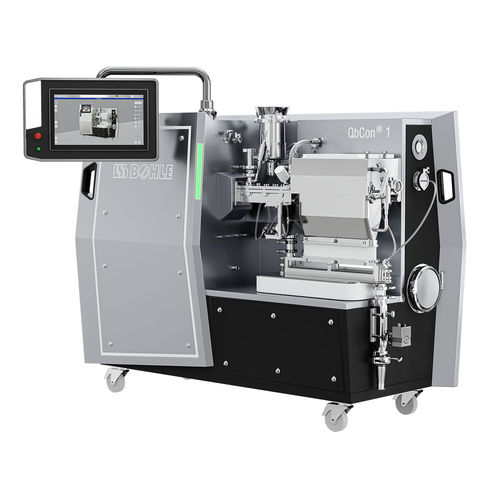
#Product Trends
QbCon® 1 sets new standards in the pharmaceutical industry
Three continuous processes combined in one system
With QbCon® 1, L.B. Bohle Maschinen + Verfahren GmbH presented a means for solids production in the pharmaceutical industry to combine the three processes of continuous raw material dosing (mixing of excipients and active ingredients), continuous twin-screw moist granulation and continuous drying in one plant including integrated control.
QbCon® 1 is designed for a throughput of 0.5 kg/h to 4.0 kg/h, so that the system can be used e.g. for the research and development of new drugs where only very small quantities of unique active ingredients are available.
QbCon® 1 meets the main quality requirements of continuous manufacturing in the pharmaceutical industry with regard to:
• short residence times of the granules in the dryer with simultaneous narrow residence time distribution ("plug flow", with extremely low back-mixing of particles);
• traceability of the materials used (excipients and active ingredients) in a continuous process;
• uniform, reproducible drying of all granule particles of different sizes;
• long service life of the exhaust air filters, without interruption of the drying process or filter change.
QbCon® 1 – Revolutionary system for solids production
Currently, only quasi-continuous dryers operating in batches exist on the supplier market for the pharmaceutical industry. These systems are prone to filter blocking, which leads to frequent process interruptions, cleaning or replacement of the filters.
With the QbCon® 1, the first real-continuous dryer with a long uninterrupted process time (> 8 h, "24/7") is now available on the market.
The unique selling point of QbCon® 1 lies in the real-continuous dryer. Although there are several semi-continuous or quasi-continuous dryers (with several drying chambers operating in parallel) for granules on the market at the moment, none of them meets the high quality requirements of the pharmaceutical industry.
QbCon® 1 has a clear advantage over semi-continuous dryers
In addition, semi-continuous dryers cannot deliver the promised benefit of reducing waste products that do not meet specifications to the extent of the fully continuous dryer of the QbCon® 1. Due to the high volume of material, which stays in different chambers during semi-continuous drying, it is not possible to remove small partial quantities from a continuous stream. In fact, the opposite is true with current dryers on the market. Due to the high degree of mixing, whole or partial batches must be discarded when there is doubt.
With QbCon® 1, the moist granules leave the twin-screw granulator and are conveyed directly to the distributor bottom of the continuous dryer where they are dried with hot air and conveyed towards the outlet by mechanical excitation. During this conveying process, the granule particles no longer mix, as they remain very close together.
The conveying of the granules and the air flow are independently adjustable. Drying of the granules can therefore be controlled via the supply air temperature, the supply air volume and the conveying speed.
QbCon® 1 with technical edge
A new principle of filter cleaning keeps the filter surface for the exhaust air permanently clear. For the first time ever, continuous drying can be carried out permanently and without interrupting the process.
In all tests conducted, QbCon® 1 works without process interruption or disturbance. All critical process parameters of dosing, granulation and drying are always constant throughout the entire test period. A noteworthy benefit is the small amount of granules in the exhaust air filters. This is due to the extremely low fluidisation of the granules in the dryer. During cleaning, the filters are completely free of product residue.
Efficient drying
With regard to the moisture content of the dried granules, QbCon® 1 achieves a constant and reproducible result, which is particularly important for a continuous process. The drying is so effective and efficient that some of the granules showed moisture content which was below that of the raw material. This is particularly relevant for moisture-sensitive products. If the residual moisture is considered too low, it is possible to adapt the process to shorter drying times (= residence times), lower temperatures and air flow rates in order to achieve higher residual moisture contents.
In addition to residual moisture, a consistent granule size distribution is important for further processing of the granules. The continuous granulation and drying process in QbCon® 1 leads to constant granule sizes, which are not changed by the gentle drying process. The residence time of the granules in the dryer is the time during which the moist granules are exposed to the drying air flow. A constant residence time distribution is therefore decisive for consistent drying results. All results reveal an ideal, very narrow residence time distribution of the measured distributions for a continuous dryer. All granules are conveyed through the dryer at the same speed in order to achieve uniform drying. Back-mixing of the granules in the dryer is also low.
Your advantages with QbCon® 1:
• The truly continuous use of QbCon® 1 increases efficiency by up to 30 percent with 24/7 production thanks to continuous filter cleaning.
• Product quality can be improved by up to 20 percent, since the product flow is monitored inline by means of spectroscopic methods (e.g. NIR); and
• the risk of contamination through the operator is eliminated as it is not necessary to dismantle dry filters covered with fine dust.
• Close process monitoring via PAT leads to high-quality products, high patient safety, lower costs, a better process understanding and control.
• The integrated product temperature measurement at the outlet prevents decomposition of the API or other structural changes and drying can already be controlled indirectly.
• The NIR measurement at the dryer outlet ensures that the quality variable of “residual moisture” can be monitored and controlled in real time.
• On customer request, this method can also be integrated into the control system, which further increases the degree of automation. Last but not least, the twin-screw granulator, which is connected upstream of the dryer, also offers the option of using variable probes for real-time monitoring thanks to its flexibly designed ports.





